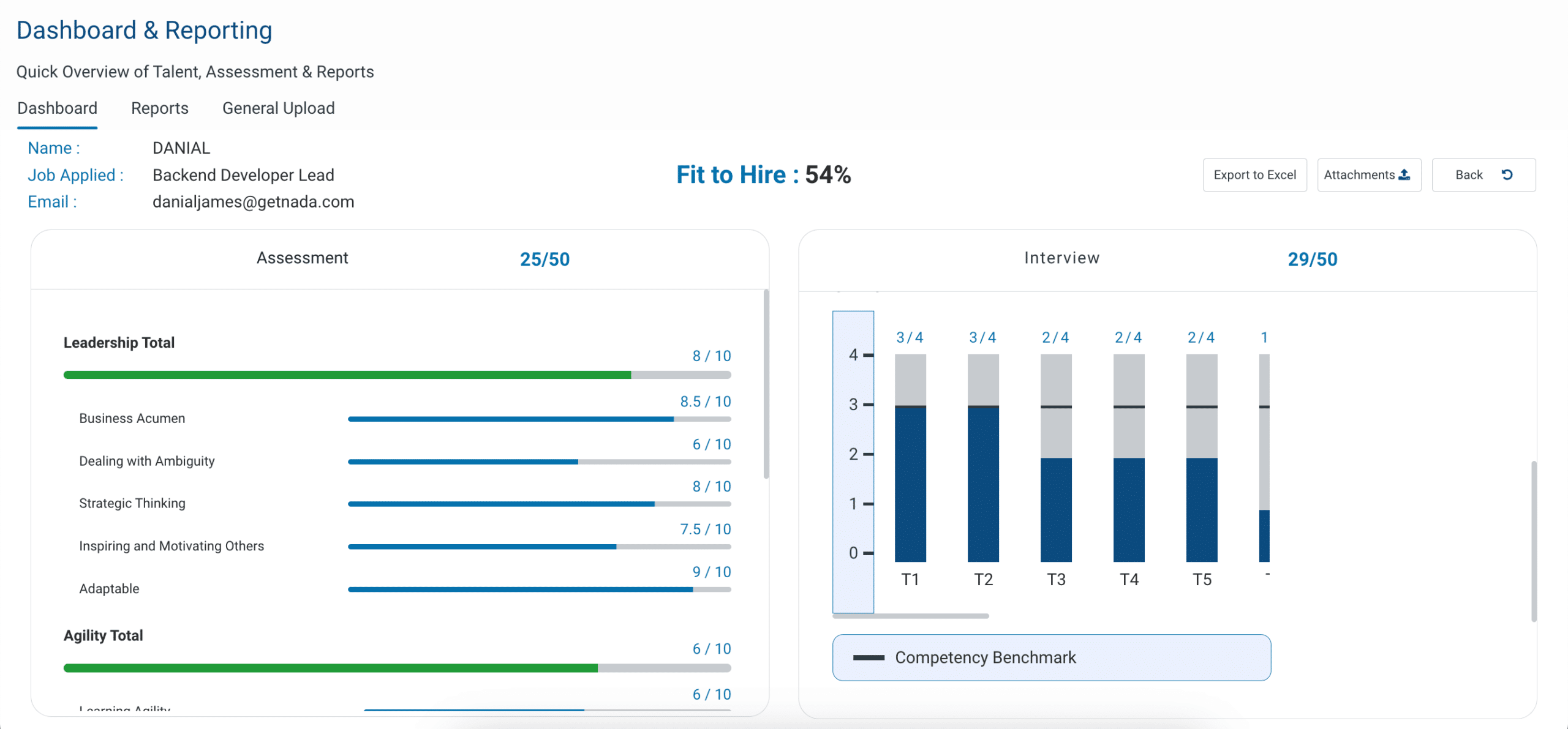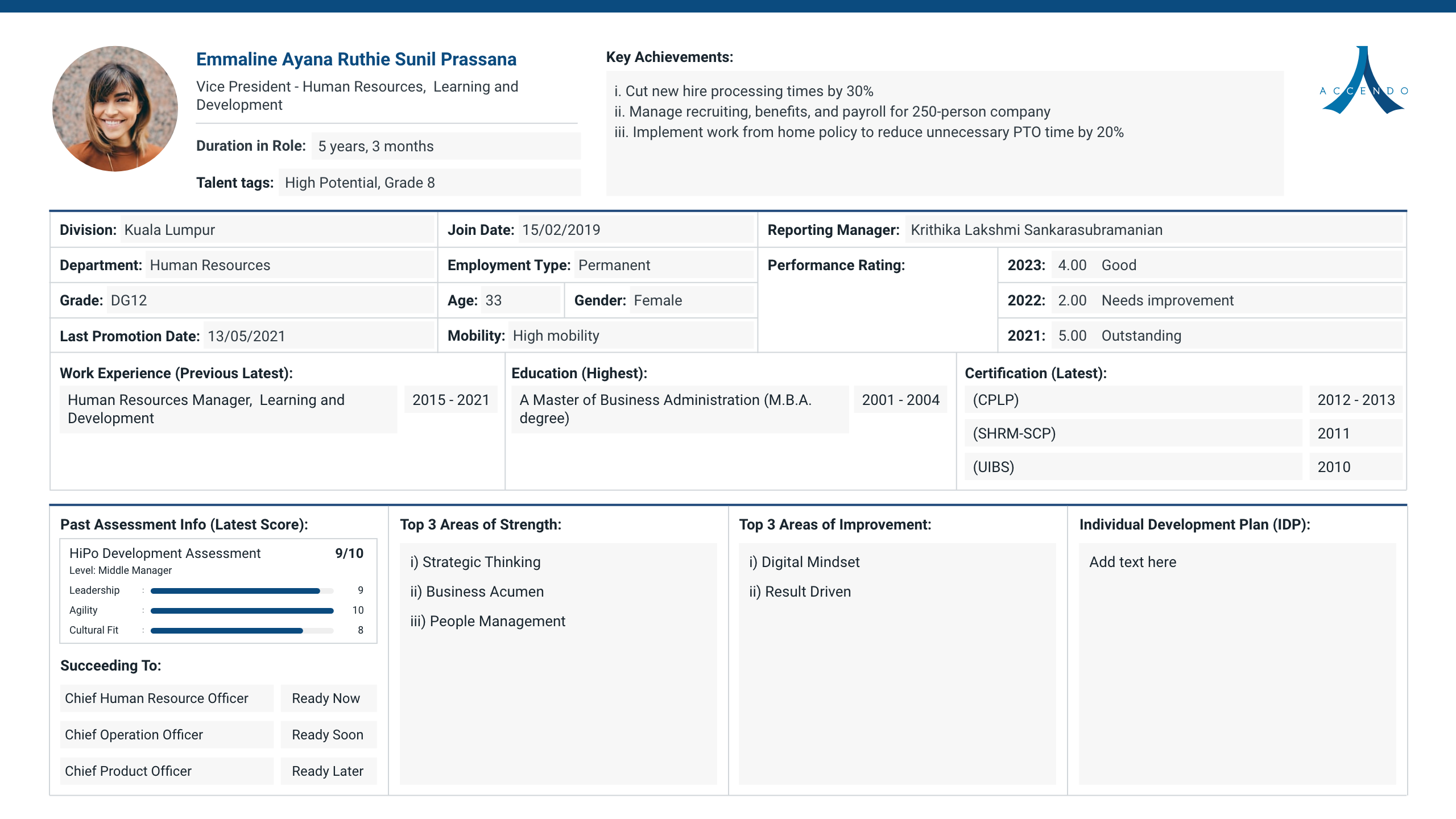
Succession planning is essential for organisations to ensure smooth leadership transitions and continuity. Our blog today covers the importance of succession planning, steps to choose the right succession planning solution, five top succession planning tools, the best software options for 2023, and how top organisations leveraged Accendo for their succession planning.
Introduction
Succession planning is a crucial aspect of organisational management that focuses on identifying and developing potential leaders to ensure continuity and sustainability of an organisation. Imagine the sudden departure of your CEO or another vital team member without notice. How would your company cope? What immediate tasks would demand attention to safeguard your business?
According to a survey by the Institute for Corporate Productivity, companies with a formalised succession planning process are 67% more likely to identify future leaders compared to organisations without such processes.
Investing in the right succession planning solution enables you to identify and develop emerging leaders who will drive your organisation’s future success.
In this blog, we will explore succession planning and its significance, how to choose a solution for your organisation, the top tools for 2023, and the five pitfalls of succession planning and how to avoid them.
Why Succession Planning is Important
Succession planning holds a paramount position in the corporate world. It entails a deliberate and proactive process of identifying, developing, and nurturing individuals within an organisation to assume crucial leadership roles.
When key personnel leave unexpectedly, organisations may encounter numerous challenges. A sudden leadership vacuum can result in disruptive operations, create uncertainty among employees, and adversely impact overall business performance.
However, with a well-defined plan in place, these risks can be mitigated, ensuring a smooth transition of leadership and minimising the negative effects associated with departures. Here are four reasons why succession planning is important:
- Business continuity: Succession planning grooms suitable individuals for key roles, reducing downtime and disruptions during leadership transitions, and ensuring seamless operations even in times of change.
- Talent development and growth: Succession planning motivates employees with opportunities for advancement and recognition based on merit, fostering loyalty, commitment, and increased productivity.
- Addressing skill gaps: Succession planning identifies potential skill gaps in future leaders, enabling targeted training and development programs to prepare potential successors for leadership roles.
- Strong leadership pipeline: Cultivating a pool of talented leaders creates a robust leadership pipeline, contributing to long-term organisational success, reducing reliance on external recruitment, and maintaining alignment with the company’s values and goals.
Succession planning is not merely a business strategy but a vital aspect of organisational growth and stability. Embracing it ensures continued success and adaptability for companies in a dynamic and ever-changing business landscape.
How to Choose the Right Succession Planning Solution?
Selecting the right succession planning solution is critical for any organisation. It involves a careful evaluation of various factors to ensure the chosen solution aligns with the specific needs and goals of your organisation. Here are some steps to help you choose the best succession planning solution:
Assess your organisational requirements
Start by understanding your organisation’s unique requirements and goals for succession planning. Consider factors such as the size of your organisation, the number of key positions, the complexity of your talent pool, and any specific features or functionalities you need.
Research available options
Conduct thorough research to identify the best succession planning solutions available in the market. Explore different vendors, their offerings, and their track record in providing effective succession planning solutions. Pay attention to their reputation, industry experience, and client base.
Evaluate key features and functionality
Assess the features and functionalities offered by each solution. Look for capabilities such as talent identification and assessment, performance management integration, development planning, competency tracking, and reporting and analytics. Consider which features align with your company’s requirements that will best support your succession planning strategy.
Request a demo or a trial
Before making your decision, it is important to request a demo or trial of the solutions that interest you. A demo or trial provides invaluable insights and helps you confidently select the best succession planning solution for your organisation. It also allows you to test the software’s features and determine its suitability for your business.
Consider integration and compatibility
Assess the compatibility of the succession planning solution with your existing systems and processes. Consider whether the solution can integrate smoothly with your Human Resources Information System (HRIS) or other relevant software. Compatibility and integration are crucial for data synchronisation, streamlining processes, and maximising efficiency.
User-friendliness and ease of implementation
A user-friendly interface is essential for successful adoption and engagement among employees and stakeholders. Consider the ease of implementation and the learning curve required for your HR team and employees to use the solution effectively. Look for intuitive interfaces and comprehensive training and support provided by the vendor to facilitate a smooth onboarding process.
The Aberdeen Group conducted a study and found that companies with effective succession planning had a 10% higher year-over-year improvement in their revenue compared to companies with ineffective or no succession planning.
Selecting a succession planning solution is not a one-size-fits-all approach. Each organisation is unique, so take the time to evaluate your options thoroughly. Doing so with due diligence allows you to choose the best succession planning solution that suits your organisation’s needs and empowers you to effectively develop and nurture future leaders.
5 Best Succession Planning Tools/Software for 2023
Discover the top five succession planning software that can revolutionise your talent management strategies. From comprehensive talent profiling to seamless integration with HR systems, these tools offer the perfect solution for identifying and developing future leaders within your organisation. Streamline your succession planning process with these powerful and intuitive tools.
Now, let us look at each succession planning software in more detail and provide examples of how you can use each one in practice.
According to a report by DDI, organisations with strong leadership development programs, including succession planning, outperformed their industry peers by 19% in terms of increased revenue.
Accendo
Accendo’s succession planning solution includes a combination of various talent assessment tools, an extensive success profile library, and a matching algorithm that speeds up the talent identification process to deliver quicker, cost-effective, and more accurate insights while ensuring a strong leadership pipeline to drive the business.
Here are three unique selling points of Accendo’s succession planning solution.
Holistic talent evaluation
Our innovative approach utilises an array of data points, optimising talent identification while minimising biases. By combining multiple factors, we deliver a holistic view of candidates, ensuring the right fit for the role.

Extensive global success profiles
With an extensive library of over 3,000 role profiles from around the world, we guarantee candidates are accurately assessed against universal benchmarks for job success.
Quick yet reliable decision-making
Time-sensitive decisions demand reliability, and our time-tested algorithms, honed through years of consulting expertise, empower you to quickly identify successors with confidence.
A key assessment tool that is commonly used in succession planning is 360-degree feedback tool.
Gathering feedback from stakeholders is recommended during the succession planning process. These stakeholders include the employee’s superior, peers, direct reports, and clients, who regularly interact and collaborate with the potential successor. Collecting feedback from multiple perspectives helps the employee better understand their performance, skill levels, and behaviour as perceived by others.
Accendo’s 360-Five Feedback allows you to assess the demonstration of your potential successor’s leadership qualities. Incorporating this tool as an additional metric ensures that multiple perspectives are considered when making the final decision.
Some noteworthy features include:
- Talent Identification: Accendo offers advanced assessment tools to evaluate employee skills, competencies, and potential for future leadership positions.
- Succession Planning: The software facilitates the creation and management of succession plans, allowing organisations to identify and groom suitable successors for key roles.
- Analytics and Reporting: The software offers robust analytics and reporting capabilities, enabling organisations to track succession planning progress, identify skill gaps, and make data-driven decisions.
Accendo’s succession planning solution enables organisations to broaden and deepen their talent search, use multifaceted data to assess their talents and conduct data-driven talent discussions prior to planning what’s next after these talent discussions.
With Accendo, we completed 3x faster, relied on advanced dashboard for analysing results and real-time talent decisions, and met our board’s robust requirements.
Shamsul Zahrin Sulaiman
Head, HRA, IT & Legal
Central Spectrum
I came across TalentPulse which is Accendo’s product. I see a lot of potential in TakentPulse to be of value for Organizational Talent Leaders and Top Management
Combin Khambatta
Head of People Development
Japfa LTD
Mercer | Mettl
Mettl, now known as Mercer | Mettl, is a talent assessment and online examination platform that provides a range of solutions for talent management and HR needs. The platform focuses on helping organisations make informed decisions about hiring, training, and developing their workforce through data-driven insights gained from assessments and evaluations. Its key features include:
- Assessment Creation and Customisation: Mettl enables organisations to create and customise various types of assessments, including cognitive, behavioural, and technical tests.
- 360-Degree Feedback: Mettl offers a mechanism for comprehensive feedback through its 360-degree assessment tools, which help evaluate an employee’s performance from multiple perspectives.
- Behavioural and Personality Assessments: The platform includes tools to assess an individual’s behavioural traits, personality characteristics, and emotional intelligence. This can be valuable for team composition and leadership development.
- Analytics and Reporting: The platform provides detailed analytics and reports based on assessment results, offering insights into candidates’ and employees’ strengths, weaknesses, and areas for improvement.
Plum
Plum is an AI-powered talent assessment and matching platform that supports succession planning by identifying individuals with the highest potential for success in leadership positions. Some notable use cases and features include:
- Talent Analytics: Plum uses AI and psychometric assessments to analyse individuals’ abilities, behaviours, and preferences, generating data-driven talent insights for succession planning.
- Success Profiles: The software helps create success profiles for different roles within an organisation, highlighting the behavioural and cognitive attributes required for success in those positions.
- Succession Readiness: Plum offers a readiness score that assesses an individual’s potential and readiness for specific leadership roles, assisting in identifying suitable successors.
- Bias Mitigation: The platform is designed to reduce unconscious bias in the talent selection process by focusing on objective data and eliminating human biases.
TalentGuard
TalentGuard is a talent management platform that includes a succession planning module to help you identify and develop future leaders. Some notable features and use cases include:
- Competency Framework: The software provides a competency framework that enables you to define the skills, knowledge, and behaviours required for different roles, aiding in succession planning.
- Performance Assessments: TalentGuard allows you to conduct performance assessments and 360-degree feedback to evaluate your employees’ potential for leadership positions.
- Development Plans: The platform supports the creation of personalised development plans, offering learning resources, training programs, and career pathing tools to help employees grow.
- Succession Analytics: TalentGuard offers robust analytics and reporting capabilities, providing insights into talent pipelines, skill gaps, and the effectiveness of succession planning strategies.
Saba Cloud
Saba Cloud is a talent management platform that includes succession planning to support organisations in identifying and developing future leaders. The key use cases and features of Saba Cloud include:
- Succession Planning Workflows: The software provides configurable workflows to streamline the succession planning process, allowing organisations to define key positions and identify suitable successors.
- Talent Pools and Readiness: Saba Cloud enables the creation of talent pools based on employee performance, potential, and aspirations. It also assesses readiness for leadership roles through competency-based assessments.
- Development and Learning: The platform offers personalised development plans, learning resources, and career pathing tools to help employees build the skills required for future leadership positions.
- Performance Management Integration: Saba Cloud integrates with performance management modules, allowing organisations to align performance assessments with succession planning and identify high-potential employees.
How Top Organisations Leveraged Accendo’s Platform to Achieve Seamless Succession Planning?
The overall succession planning journey with Accendo encompasses five steps.
Step 1: Define the management criteria
TalentPulse utilises a holistic measurement framework across four quadrants that helps organisations to define management criteria.

Behavioural and motivation assessments are used to identify leaders with the right behaviours, assess agility with cognitive assessments, evaluate cultural fit based on organisational values, and measure technical proficiency through customised assessments for different roles. This comprehensive approach aids in identifying and developing talent for effective leadership and succession planning.
Step 2: Combine assessment tools
Accendo’s multi-dimensional assessment tools offer deeper insights into individuals and their talents, covering behavioural preferences, behaviour in simulated challenges, and behaviours in actual contexts. This approach ensures a comprehensive understanding of individuals and accurate evaluation of competencies across different job levels within the organisation.

Step 3: Obtain consolidated candidate report outputs
TalentPulse offers consolidated report outputs, including the Development Report with assessment results and development areas, and the Executive Report with additional insights from interviews. These reports aid in assessing candidates, identifying growth areas, and making informed decisions for talent development and succession planning.

Step 4: Create a success profile
TalentPulse enables organisations to create success profiles defining desired qualities and skills for key business roles. With 30 years of research, Accendo offers a vast library of over 3,000 globally benchmarked profiles for succession planning, encompassing industry-specific and corporate functions across all levels. The collection is regularly updated with 20 frameworks spanning 16 industries, ensuring alignment with current job market demands.

Step 5: Strategic talent review with dashboards
Accendo’s Succession Planning solution enables organisations to identify and develop future leaders with intuitive TalentPulse dashboards, facilitating comprehensive assessments, succession planning, and identifying suitable successors for key roles. The platform offers insights into employees’ strengths, gaps, and simplifies talent review meetings, aiding informed decision-making for effective succession strategies.

Research by SHRM indicates that B2B companies with a formal succession planning process experience a 70% higher success rate in filling leadership positions compared to organisations without such processes.
This underscores the importance of structured succession planning in identifying and developing the right talent for key roles in B2B companies.
Success Story on Succession Planning

Success Starts Now: Take the First Step with Succession Planning
Ready to take charge of your organisation’s future?
Succession planning is the key to unlocking your talent’s true potential, ensuring a smooth and successful transition to new leadership. With Accendo’s Succession Planning solution, you’ll have the power to identify and nurture emerging leaders, making your company resilient to any unforeseen challenges.
Don’t leave your future to chance—empower your organisation with Accendo’s advanced tools for talent management and watch your success story unfold. Take the first step towards sustained success today. Accendo offers a FREE TRIAL for succession planning to test your journey ahead. Book a FREE TRIAL today.

Frequently Asked Questions (FAQs)
Why is succession planning important?
Succession planning is crucial as it ensures organisational continuity by identifying and grooming potential successors. It minimises disruptions caused by unexpected departures, retirements, or talent gaps. Additionally, succession planning allows organisations to proactively address future talent needs, aligning competent leaders with key roles and ensuring long-term success.
What are the 4 stages of succession planning?
The four stages of succession planning are identification and assessment, development and preparation, selection and appointment, and transition and monitoring.
What is a succession planning framework?
A succession planning framework is a structured approach or model that guides organisations in effective succession planning implementation. It typically includes processes for identifying and developing potential successors, creating development plans, and managing leadership transitions.
What are the parameters to consider while looking at succession planning software?
The parameters to consider include its scalability, user-friendliness, integration capabilities with existing systems, data security features, reporting and analytics functionalities, customisation options, performance management and talent assessment features, compatibility with mobile devices for remote access, and customer support provided by the software vendor.
What roles are critical for succession planning?
Critical roles for succession planning typically include top executive positions such as the C-suite executives who are responsible for strategic decision-making and setting the organisation’s direction. Other key management roles that directly impact operational efficiency, revenue generation, or key projects can be considered, which include department heads, project managers, and functional leaders.
Page Contents






